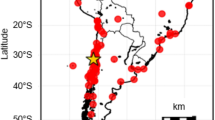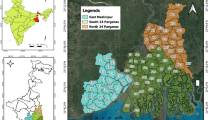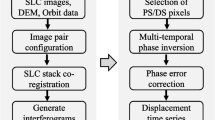Abstract
The Zongling landslide (Nayong, Guizhou, China) is dominated by a unique karst landscape area with many landslide masses. In this paper, an improved Interferometric Point Target Analysis (IPTA) method is proposed to identify and monitor the Zongling landslide. In this method, the Anderson-Darling test is applied to distributed scatterer (DS) selection, and DS and persistent scatterer (PS) are combined to improve the density of measurement points in vegetation area. Moreover, this method is also characterized by the appropriate combination of differential interferograms produced by a small baseline subsets and the employment of the phase triangulation algorithm to estimate the optimal phase. Combining 105 scenes of C-band Sentinel-1A ascending and descending data acquired during 2014–2018, the method is applied to retrieve time series displacement for the large-scale landslide in Zongling Town. Finally, three accelerating landslides are identified from our result, which is consistent with ALOS PALSAR differential interferometry synthetic aperture radar (DInSAR) results and field investigation. The influencing factors and deformation mechanism of the Zongling landslide are also analysed. Our monitoring results will help the local government to conduct regular inspections and strengthen disaster prevention in mountain areas.





















Similar content being viewed by others
References
Barra A, Solari L, Béjar-Pizarro M, Monserrat O, Bianchini S, Herrera G, Crosetto M, Sarro R, González-Alonso E, Mateos RM (2017) A methodology to detect and update active deformation areas based on sentinel-1 SAR images. Remote Sens 9:1002
Béjar-Pizarro M, Notti D, Mateos RM, Ezquerro P, Centolanza G, Herrera G, Bru G, Sanabria M, Solari L, Duro J (2017) Mapping vulnerable urban areas affected by slow-moving landslides using sentinel-1 InSAR data. Remote Sens 9:876
Berardino P, Fornaro G, Lanari R, Sansosti E (2002) A new algorithm for surface deformation monitoring based on small baseline differential SAR interferograms. IEEE Trans Geosci Remote Sens 40:2375–2383
Bianchini S, Herrera G, Mateos R, Notti D, Garcia I, Mora O, Moretti S (2013) Landslide activity maps generation by means of persistent scatterer interferometry. Remote Sens 5(12):6198–6222
Bonì R, Bordoni M, Colombo A, Lanteri L, Meisina C (2018) Landslide state of activity maps by combining multi-temporal A-DInSAR (lambda). Remote Sens Environ 217:172–190
Carnec C, Massonnet D, King C (1996) Two examples of the use of SAR interferometry on displacement fields of small spatial extent. Geophys Res Lett 23:3579–3582
Cascini L, Fornaro G, Peduto D (2009) Analysis at medium scale of low-resolution DInSAR data in slow-moving landslide-affected areas. ISPRS J Photogramm Remote Sens 64:598–611
Cascini L, Fornaro G, Peduto D (2010) Advanced low- and full-resolution DInSAR map generation for slow-moving landslide analysis at different scales. Eng Geol 112:29–42
Catani F, Farina P, Moretti S, Nico G, Strozzi T (2005) On the application of SAR interferometry to geomorphological studies: estimation of landform attributes and mass movements. Geomorphology 66:119–131
Cigna F, Bateson LB, Jordan CJ, Dashwood C (2014) Simulating SAR geometric distortions and predicting persistent scatterer densities for ers-1/2 and ENVISAT C-band SARand InSAR applications: Nationwide feasibility assessment to monitor the landmass of great Britain with SAR imagery. Remote Sens Environ 152:441–466
Cigna F, Bianchini S, Casagli N (2013) How to assess landslide activity and intensity with persistent scatterer interferometry (psi): the psi-based matrix approach. Landslides 10:267–283
Colesanti C, Wasowski J (2006) Investigating landslides with space-borne synthetic aperture radar (SAR) interferometry. Eng Geol 88:173–199
Corsini A, Farina P, Antonello G, Barbieri M, Casagli N, Coren F, Guerri L, Ronchetti F, Sterzai P, Tarchi D (2007) Space-borne and ground-based SAR interferometry as tools for landslide hazard management in civil protection. Int J Remote Sens 27:2351–2369
Costantini M, Falco S, Malvarosa F, Minati F, Trillo F, Vecchioli F (2014) Persistent scatterer pair interferometry: approach and application to COSMO-SkyMed SAR data. IEEE Journal of Selected Topics in Applied Earth Observations and Remote Sensing 7:2869–2879. https://doi.org/10.1109/jstars.2014.2343915
Del Soldato M, Riquelme A, Bianchini S, Tomàs R, Di Martire D, De Vita P, Moretti S, Calcaterra D (2018) Multisource data integration to investigate one century of evolution for the Agnone landslide (Molise, southern Italy). Landslides 15:2113–2128
Dong J, Zhang L, Tang M, Liao M, Xu Q, Gong J, Ao M (2018) Mapping landslide surface displacements with time series SAR interferometry by combining persistent and distributed scatterers: a case study of Jiaju landslide in Danba, China. Remote Sens Environ 205:180–198
Du J-C, Teng H-C (2007) 3d laser scanning and GPS technology for landslide earthwork volume estimation. Autom Constr 16:657–663
Fan X, Xu Q, Scaringi G, Zheng G, Huang R, Dai L, Ju Y (2019) The “long” runout rock avalanche in Pusa, China, on august 28, 2017: a preliminary report. Landslides 16:139–154
Farina P, Colombo D, Fumagalli A, Marks F, Moretti S (2006) Permanent scatterers for landslide investigations: outcomes from the ESA-SLAM project. Eng Geol 88:200–217
Ferretti A, Prati C, Rocca F (2000) Nonlinear subsidence rate estimation using permanent scatterers in differential SAR interferometry. IEEE Trans Geosci Remote Sens 38:2202–2212
Ferretti A, Prati C, Rocca F (2001) Permanent scatterers in SAR interferometry. IEEE Trans Geosci Remote Sens 39:8–20
Ferretti A, Fumagalli A, Novali F, Prati C, Rocca F, Rucci A (2011) A new algorithm for processing interferometric data-stacks: SqueeSAR. IEEE Trans Geosci Remote Sens 49:3460–3470
Frodella W, Ciampalini A, Gigli G, Lombardi L, Raspini F, Nocentini M, Scardigli C, Casagli N (2016) Synergic use of satellite and ground based remote sensing methods for monitoring the San Leo rock cliff (northern Italy). Geomorphology 264:80–94
García-Davalillo JC, Herrera G, Notti D, Strozzi T, Álvarez-Fernández I (2013) Dinsar analysis of ALOS PALSAR images for the assessment of very slow landslides: the Tena valley case study. Landslides 11:225–246
García-Davalillo JC, Herrera G, Notti D, Strozzi T, Álvarez-Fernández I (2014) DInSAR analysis of ALOS PALSAR images for the assessment of very slow landslides: the Tena valley case study. Landslides 11:225–246
Goel K, Adam N (2014) A distributed scatterer interferometry approach for precision monitoring of known surface deformation phenomena. IEEE Trans Geosci Remote Sens 52:5454–5468
Gomba G, González FR, De Zan F (2016) Ionospheric phase screen compensation for the sentinel-1 tops and ALOS-2 ScanSAR modes. IEEE Trans Geosci Remote Sens 55:223–235
Greif V, Vlcko J (2011) Monitoring of post-failure landslide deformation by the PS-InSAR technique at Lubietova in Central Slovakia. Environ Earth Sci 66:1585–1595
Herrera G, Davalillo J, Mulas J, Cooksley G, Monserrat O, Pancioli V (2009) Mapping and monitoring geomorphological processes in mountainous areas using psi data: Central Pyrenees case study. Nat Hazards Earth Syst Sci 9:1587
Herrera G, Notti D, García-Davalillo JC, Mora O, Cooksley G, Sánchez M, Arnaud A, Crosetto M (2011) Analysis with C-and X-band satellite SAR data of the Portalet landslide area. Landslides 8:195–206
Herrera G, Gutiérrez F, García-Davalillo JC, Guerrero J, Notti D, Galve JP, Fernández-Merodo JA, Cooksley G (2013) Multi-sensor advanced DInSAR monitoring of very slow landslides: the Tena Valley case study (Central Spanish Pyrenees). Remote Sens Environ 128:31–43
Hooper A (2008) A multi-temporal InSAR method incorporating both persistent scatterer and small baseline approaches. Geophys Res Lett 35
Hooper A, Zebker H, Segall P, Kampes B (2004) A new method for measuring deformation on volcanoes and other natural terrains using InSAR persistent scatterers. Geophys Res Lett 31
Hooper A, Segall P, Zebker H (2007) Persistent scatterer interferometric synthetic aperture radar for crustal deformation analysis, with application to Volcán Alcedo, Galápagos. Journal of Geophysical Research 112
Huang Q-H, Cai Y-L (2007) Spatial pattern of karst rock desertification in the middle of Guizhou province, southwestern China. Environ Geol 52:1325–1330
Huang M, Qi S, Shang G (2012) Karst landslides hazard during 1940–2002 in the mountainous region of Guizhou province, Southwest China. Nat Hazards 60:781–784
Intrieri E, Raspini F, Fumagalli A, Lu P, Del Conte S, Farina P, Allievi J, Ferretti A, Casagli N (2018) The Maoxian landslide as seen from space: detecting precursors of failure with sentinel-1 data. Landslides 15:123–133
Kampes BM, Hanssen RF (2004) Ambiguity resolution for permanent scatterer interferometry. IEEE Trans Geosci Remote Sens 42:2446–2453
Komac M, Holley R, Mahapatra P, van der Marel H, Bavec M (2015) Coupling of GPS/GNSS and radar interferometric data for a 3d surface displacement monitoring of landslides. Landslides 12:241–257
Lanari R, Mora O, Manunta M, Mallorquí JJ, Berardino P, Sansosti E (2004) A small-baseline approach for investigating deformations on full-resolution differential SAR interferograms. IEEE Trans Geosci Remote Sens 42:1377–1386
Lu P, Casagli N, Catani F, Tofani V (2012) Persistent scatterers interferometry hotspot and cluster analysis (PSI-HCA) for detection of extremely slow-moving landslides. Int J Remote Sens 33:466–489
Massonnet D, Feigl KL (1998) Radar interferometry and its application to changes in the earth's surface. Rev Geophys 36
Michoud C, Baumann V, Lauknes TR, Penna I, Derron M-H, Jaboyedoff M (2016) Large slope deformations detection and monitoring along shores of the Potrerillos dam reservoir, Argentina, based on a small-baseline InSAR approach. Landslides 13:451–465
Mora O, Mallorqui JJ, Broquetas A (2003) Linear and nonlinear terrain deformation maps from a reduced set of interferometric SAR images. IEEE Trans Geosci Remote Sens 41:2243–2253
Niethammer U, James R, Rothmund S (2012) UAV-based remote sensing of the Super-Sauze landslide: evaluation and results. Eng Geol 128:2–11
Notti D, Herrera G, Bianchini S, Meisina C, García-Davalillo JC, Zucca F (2014) A methodology for improving landslide psi data analysis. Int J Remote Sens 35:2186–2214
Parizzi A, Brcic R (2010) Adaptive InSAR stack multilooking exploiting amplitude statistics: a comparison between different techniques and practical results. IEEE Geosci Remote Sens Lett 8:441–445
Perissin D, Wang T (2011) Time-series InSAR applications over urban areas in China. IEEE Journal of Selected Topics in Applied Earth Observations and Remote Sensing 4:92–100
Perissin D, Wang T (2012) Repeat-pass SAR interferometry with partially coherent targets. IEEE Trans Geosci Remote Sens 50:271–280
Raspini F, Bianchini S, Ciampalini A, Del Soldato M, Solari L, Novali F, Del Conte S, Rucci A, Ferretti A, Casagli N (2018) Continuous, semi-automatic monitoring of ground deformation using sentinel-1 satellites. Sci Rep 8:7253
Raspini F, Moretti S, Casagli N (2013) Landslide mapping using SqueeSAR data: Giampilieri (Italy) case study. Springer, Landslide science and practice, pp 147–154
Righini G, Pancioli V, Casagli N (2012) Updating landslide inventory maps using persistent scatterer interferometry (PSI). Int J Remote Sens 33:2068–2096
Rosi A, Tofani V, Tanteri L, Stefanelli CT, Agostini A, Catani F, Casagli N (2018) The new landslide inventory of Tuscany (Italy) updated with PS-InSAR: geomorphological features and landslide distribution. Landslides 15:5–19
Rott H, Scheuchl B, Siegel A, Grasemann B (1999) Monitoring very slow slope movements by means of SAR interferometry: a case study from a mass waste above a reservoir in the Ötztal Alps, Austria. Geophys Res Lett 26:1629–1632
Schmidt DA, Bürgmann R (2003) Time-dependent land uplift and subsidence in the Santa Clara valley, California, from a large interferometric synthetic aperture radar data set. Journal of Geophysical Research: Solid Earth 108
Shi X, Liao M, Li M, Zhang L, Cunningham C (2016) Wide-area landslide deformation mapping with multi-path ALOS PALSAR data stacks: a case study of Three Gorges area, China. Remote Sens 8:136
Squarzoni C, Delacourt C, Allemand P (2005) Differential single-frequency GPS monitoring of the La Valette landslide (French Alps). Eng Geol 79:215–229
Stiros SC, Vichas C, Skourtis C (2004) Landslide monitoring based on geodetically derived distance changes. J Surv Eng 130:156–162
Strozzi T, Farina P, Corsini A, Ambrosi C, Thüring M, Zilger J, Wiesmann A, Wegmüller U, Werner C (2005) Survey and monitoring of landslide displacements by means of l-band satellite SAR interferometry. Landslides 2:193–201
Tang P, Chen F, Guo H, Tian B, Wang X, Ishwaran N (2015) Large-area landslides monitoring using advanced multi-temporal InSAR technique over the giant panda habitat, Sichuan, China. Remote Sens 7:8925–8949
Tofani V, Raspini F, Catani F, Casagli N (2013) Persistent scatterer interferometry (psi) technique for landslide characterization and monitoring. Remote Sens 5:1045–1065
Tomás R, Li Z, Liu P, Singleton A, Hoey T, Cheng X (2014) Spatiotemporal characteristics of the Huangtupo landslide in the three gorges region (China) constrained by radar interferometry. Geophys J Int 197:213–232
Wang SJ, Liu QM, Zhang DF (2004) Karst rocky desertification in southwestern China: geomorphology, landuse, impact and rehabilitation. Land Degrad Dev 15:115–121
Werner C, Wegmuller U, Strozzi T and Wiesmann A (2003) Interferometric point target analysis for deformation mapping. IGARSS 2003 2003 IEEE International Geoscience and Remote Sensing Symposium Proceedings (IEEE Cat No 03CH37477), IEEE, pp 4362–4364
Xing A, Wang G, Li B, Jiang Y, Feng Z, Kamai T (2015) Long-runout mechanism and landsliding behaviour of large catastrophic landslide triggered by heavy rainfall in Guanling, Guizhou, China. Can Geotech J 52:971–981
Xing A, Xu Q, Zhu Y, Zhu J, Jiang Y (2016) The August 27, 2014, rock avalanche and related impulse water waves in Fuquan, Guizhou, China. Landslides 13:411–422
Yin Y, Sun P, Zhu J, Yang S (2011) Research on catastrophic rock avalanche at Guanling, Guizhou, China. Landslides 8:517–525
Yin Y, Zheng W, Liu Y, Zhang J, Li X (2010) Integration of GPS with InSAR to monitoring of the Jiaju landslide in Sichuan, China. Landslides 7:359–365
Zebker HA, Villasenor J (1992) Decorrelation in interferometric radar echoes. IEEE Transactions on Geoscience & Remote Sensing 30: 0–959
Zhang L, Lu Z, Ding X, Jung H-s, Feng G, Lee C-W (2012) Mapping ground surface deformation using temporarily coherent point SAR interferometry: application to Los Angeles basin. Remote Sens Environ 117:429–439
Zhang Z, Wang C, Zhang H, Tang Y, Liu X (2018) Analysis of permafrost region coherence variation in the Qinghai–Tibet plateau with a high-resolution terrasar-x image. Remote Sens 10:298
Zhao C, Kang Y, Zhang Q, Lu Z, Li B (2018) Landslide identification and monitoring along the Jinsha river catchment (Wudongde reservoir area), China, using the InSAR method. Remote Sens 10:993
Zhu Y, Xu S, Zhuang Y, Dai X, Lv G, Xing A (2019) Characteristics and runout behaviour of the disastrous 28 august 2017 rock avalanche in Nayong, Guizhou, China. Eng Geol 259:105154
Acknowledgements
The authors would like to thank Copernicus programme for the free access to Sentinel-1 images processed in this analysis and ALOS/PALSAR data are provided by the Third Institute of Surveying and Mapping in Guizhou Province.
Funding
This research was funded by the National Natural Science Foundation of China under Grants 41930110 and 41801348.
Author information
Authors and Affiliations
Corresponding author
Rights and permissions
About this article
Cite this article
Wang, J., Wang, C., Xie, C. et al. Monitoring of large-scale landslides in Zongling, Guizhou, China, with improved distributed scatterer interferometric SAR time series methods. Landslides 17, 1777–1795 (2020). https://doi.org/10.1007/s10346-020-01407-5
Received:
Accepted:
Published:
Issue Date:
DOI: https://doi.org/10.1007/s10346-020-01407-5




